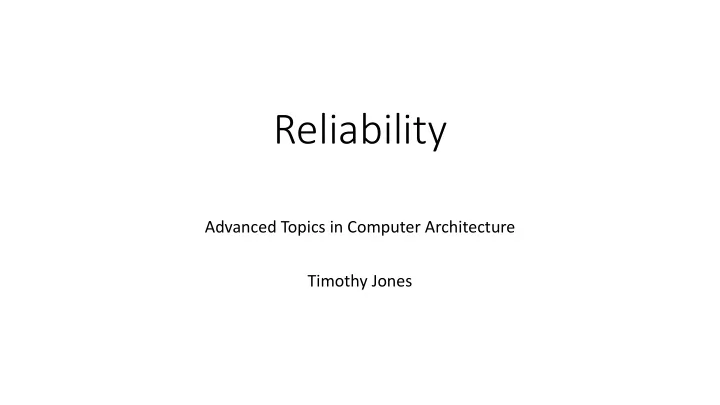

Reliability Advanced Topics in Computer Architecture Timothy Jones
Historic reliability
Silicon trends
Why we care now • Microprocessors are increasingly used in situations where we want to be sure of their correctness • Self-driving cars, nuclear power stations, medical devices, etc • Many industrial sectors mandate the use of error-detection strategies • For example, ASIL standards in automotive • With increased susceptibility to faults, even non-safety-critical computing starts to require fault tolerance https://perspectives.mvdirona.com/2009/10/you-really-do-need-ecc-memory/
Hard errors • Permanent errors that affect operation • Caused by device wearout in-the-field • Also can occur from manufacturing variabilities
Soft errors • Transient errors that can affect operation • They are transient because their effects don’t last • They are not repeatable • Caused by • Alpha particle strikes • Cosmic rays!
Error manifestation Bit read? Yes No Bit has error Benign fault; protection? no error No Yes, detection only Yes, detection Affects and correction program Detected output? unrecoverable error (DUE) No error Silent data Benign fault; corruption no error (SDC)
Identifying vulnerabilities • We can perform an analysis of processor structures to identify vulnerable state • We identify the bits that are required for architecturally correct execution (ACE) • These bits could result in incorrect output if they were flipped • The architectural vulnerability factor (AVF) is a useful metric ∑ 𝑜𝑑𝑧𝑑𝑚𝑓𝑡 𝐵𝐷𝐹𝑐𝑗𝑢𝑡 𝑗 =0 𝐵𝑊𝐺 = 𝑜𝑑𝑧𝑑𝑚𝑓𝑡 ∗ 𝑜𝑐𝑗𝑢𝑡
Identifying vulnerabilities • Bits can be ACE in some cycles, not ACE in others • Registers, for example . r0 . r1 . . . . 0x00000000feedcafe 0x1234567890123456 0x???????????????? . . .
Identifying vulnerabilities • Bits can be ACE in some cycles, not ACE in others • Registers, for example Most significant bits unACE if used . r0 . as a 32-bit r1 . number . . . 0x00000000feedcafe 0x1234567890123456 0x???????????????? . . .
Identifying vulnerabilities • Bits can be ACE in some cycles, not ACE in others • Registers, for example Most significant bits unACE if used . r0 . as a 32-bit r1 . number . . . 0x00000000feedcafe 0x1234567890123456 All ACE if read 0x???????????????? again, or all unACE if last . . read has . occurred
Identifying vulnerabilities • Bits can be ACE in some cycles, not ACE in others • Registers, for example Most significant bits unACE if used . r0 . as a 32-bit r1 . number . . . 0x00000000feedcafe 0x1234567890123456 All ACE if read 0x???????????????? again, or all All unACE until next unACE if last . . cycle where this read has . will be written to occurred and represent r2
Metrics • Two related metrics are often used to define reliability • The FIT rate (failures in time) • Defined as the total number of errors per billion device hours • MTTF (mean time to failure) • Represents the time between two errors 𝑁𝑈𝑈𝐺 ~ 1 𝐺𝐽𝑈
Dual-core lockstep • In a system with dual-core lockstep, a program is run twice on different cores • Results compared at each cycle • Introduces temporal and spatial redundancy into the system Core 0 Checker Application Correct? and data Core 1
Redundant multithreading • Run two versions of code and compare results • Can be a software scheme, perhaps with some hardware support • Or a purely hardware approach • Can run on different cores with one passing the other data • Or the same core, within a different SMT context
Taking advantage of faulty hardware • Some systems use the faulty core to provide hints to others • For example, Necromancer: Enhancing System Throughput by Animating Dead Cores Ansari, Feng, Gupta and Mahlke ISCA 2010
Approximate computing • In certain situations we can embrace errors
Approximate computing • In certain situations we can embrace errors
Summary • Reliability is a problem that has come back to haunt us • Required for safety-critical systems • Increasing needed / desired in others too • A variety of techniques developed to • Identify which parts of the core are vulnerable • Reduce vulnerability to errors by re-executing parts of the code • Embrace the unreliability for performance
Recommend
More recommend